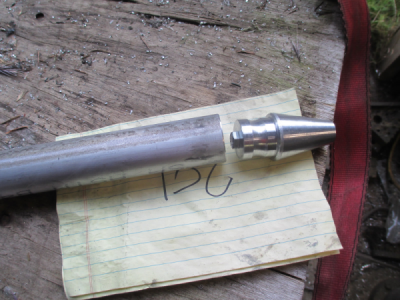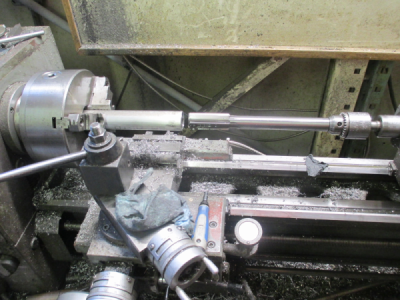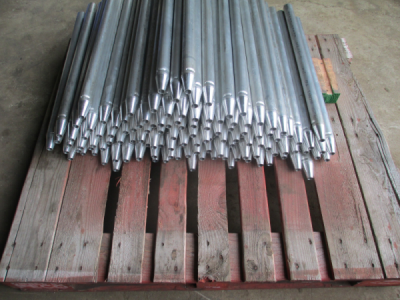- Joined
- Feb 8, 2014
- Messages
- 11,144
So here's the problem: Put these two parts together and swage to hold them together. Simple. Right? 

Well maybe not so easy. As it turns out the tubes are not consistent size or shape in the ID (or the OD for that matter, but that makes no difference in this application).
The sample tubes were pretty round and consistent and a 1.252'' dia fit the tube well with a nice snug fit. A light tap with a dead blow hammer would seat the tapered plug. And the random sample of the production tubes seem to indicate that the 1.252'' dia. would be a good fit, so turn out 400 tapered plugs @ 1.252'' dia. So these parts set in the tubs for a couple weeks while we were getting other parts fabricated.
We cut about 400 tubes to length and got set up to assemble the parts starting at about 5:00 Sunday afternoon. Place the plug at the end of the tube, tap with a dead blow hammer, and............ No, that ain't happening. Hmmm, try a bit more force, no, 4 lb hammer, nope.
OK, get out the calipers and start measuring: The plugs are fine, all 1.252'', so let's check the tubes. Found out they are really not round, and vary in average size from 1.242'' to 1.252''. ''If brute force isn't working, you're not using enough of it''. OK, with enough force maybe we can stuff the plug into the tube, so fab up a quick press out of some 4'' square tubing and a port-a-power. Well, we succeeded in buckling the 1.5'' OD, 1/8'' wall tube trying to press the parts together. OK, abandon that idea.
OK, abandon that idea.
Time for another plan. Let's freeze the plug and heat the tube and see what happens. So put the plug in the shop refrigerator freezer, and dig out the heat gun. The shop freezer did bring the plug size down to about 1.2505 and in couple of cases the heat gun expanded the tube just enough to assemble the parts. After a couple of successful parts we thought that this would work, but we needed more cold to shrink the plugs, and needed more heat to expand the tube. By this time it's about 9:30 on a Sunday evening, so how do we get more cold? Off to the local chain grocery store that's open until 11:00 to pick up some dry ice and rubbing alcohol. 10 lbs of dry ice and a couple gallons of rubbing alcohol (in 1 pint bottles, thought the cashier was going to call the bomb squad or something ). The dry ice/alcohol mix is good for about -110°F so it's the best we can do without having any liquid nitrogen. That managed to get the plug down to 1.248'', a 0.004'' reduction in size, not too bad. Grab the small propane torch and heat the tube, OK, that works for most of them, but the process takes forever and some of the tubes are so out of round that it is just not going to work. By this time it's after midnight and and we have about a half dozen tubes assembled.
). The dry ice/alcohol mix is good for about -110°F so it's the best we can do without having any liquid nitrogen. That managed to get the plug down to 1.248'', a 0.004'' reduction in size, not too bad. Grab the small propane torch and heat the tube, OK, that works for most of them, but the process takes forever and some of the tubes are so out of round that it is just not going to work. By this time it's after midnight and and we have about a half dozen tubes assembled. 
It's obvious that 400 tubes are not going to powder coat Monday morning. Need to re-think this a bit. Found a local tool vendor that had a 1.250 reamer in stock, ordered it and put it in will call for Monday morning pick up. The internet is a wonderful thing.
So set up and ream 400 tubes, that took all day Monday. Not the best solution, but boring was a bad solution because the ID of the tube is not concentric with the OD (up to 0.010'' off), and boring would create a oval rather than a round hole. The reamer will follow the existing hole and at least make it round(ish).

Bought more dry ice, and some propane for the Harbor Freight weed burner and went into production.
Here is a hundred or so completed. I gave up about 11:30 PM Monday night, the kids are still at it as of about 11:00 AM Tuesday morning and are almost done. They can pull all nighters, me not so much anymore. The parts will be going to powder coat today.

This has been a learning experience and we won't be going through this again. We are under a time crunch and have to get the parts out the door and were concentrating on other parts. We will be re-thinking the entire process and the next run will be much better thought out. Sometimes you have to make some mistakes to further the learning experience.
I'll post the solutions we come up with when we get it figured out.

Well maybe not so easy. As it turns out the tubes are not consistent size or shape in the ID (or the OD for that matter, but that makes no difference in this application).
The sample tubes were pretty round and consistent and a 1.252'' dia fit the tube well with a nice snug fit. A light tap with a dead blow hammer would seat the tapered plug. And the random sample of the production tubes seem to indicate that the 1.252'' dia. would be a good fit, so turn out 400 tapered plugs @ 1.252'' dia. So these parts set in the tubs for a couple weeks while we were getting other parts fabricated.
We cut about 400 tubes to length and got set up to assemble the parts starting at about 5:00 Sunday afternoon. Place the plug at the end of the tube, tap with a dead blow hammer, and............ No, that ain't happening. Hmmm, try a bit more force, no, 4 lb hammer, nope.
OK, get out the calipers and start measuring: The plugs are fine, all 1.252'', so let's check the tubes. Found out they are really not round, and vary in average size from 1.242'' to 1.252''. ''If brute force isn't working, you're not using enough of it''. OK, with enough force maybe we can stuff the plug into the tube, so fab up a quick press out of some 4'' square tubing and a port-a-power. Well, we succeeded in buckling the 1.5'' OD, 1/8'' wall tube trying to press the parts together.
 OK, abandon that idea.
OK, abandon that idea.Time for another plan. Let's freeze the plug and heat the tube and see what happens. So put the plug in the shop refrigerator freezer, and dig out the heat gun. The shop freezer did bring the plug size down to about 1.2505 and in couple of cases the heat gun expanded the tube just enough to assemble the parts. After a couple of successful parts we thought that this would work, but we needed more cold to shrink the plugs, and needed more heat to expand the tube. By this time it's about 9:30 on a Sunday evening, so how do we get more cold? Off to the local chain grocery store that's open until 11:00 to pick up some dry ice and rubbing alcohol. 10 lbs of dry ice and a couple gallons of rubbing alcohol (in 1 pint bottles, thought the cashier was going to call the bomb squad or something
 ). The dry ice/alcohol mix is good for about -110°F so it's the best we can do without having any liquid nitrogen. That managed to get the plug down to 1.248'', a 0.004'' reduction in size, not too bad. Grab the small propane torch and heat the tube, OK, that works for most of them, but the process takes forever and some of the tubes are so out of round that it is just not going to work. By this time it's after midnight and and we have about a half dozen tubes assembled.
). The dry ice/alcohol mix is good for about -110°F so it's the best we can do without having any liquid nitrogen. That managed to get the plug down to 1.248'', a 0.004'' reduction in size, not too bad. Grab the small propane torch and heat the tube, OK, that works for most of them, but the process takes forever and some of the tubes are so out of round that it is just not going to work. By this time it's after midnight and and we have about a half dozen tubes assembled. It's obvious that 400 tubes are not going to powder coat Monday morning. Need to re-think this a bit. Found a local tool vendor that had a 1.250 reamer in stock, ordered it and put it in will call for Monday morning pick up. The internet is a wonderful thing.
So set up and ream 400 tubes, that took all day Monday. Not the best solution, but boring was a bad solution because the ID of the tube is not concentric with the OD (up to 0.010'' off), and boring would create a oval rather than a round hole. The reamer will follow the existing hole and at least make it round(ish).

Bought more dry ice, and some propane for the Harbor Freight weed burner and went into production.

Here is a hundred or so completed. I gave up about 11:30 PM Monday night, the kids are still at it as of about 11:00 AM Tuesday morning and are almost done. They can pull all nighters, me not so much anymore. The parts will be going to powder coat today.

This has been a learning experience and we won't be going through this again. We are under a time crunch and have to get the parts out the door and were concentrating on other parts. We will be re-thinking the entire process and the next run will be much better thought out. Sometimes you have to make some mistakes to further the learning experience.
I'll post the solutions we come up with when we get it figured out.
Last edited:


